Baden whitebeam
| Baden whitebeam | ||||||||||||
|---|---|---|---|---|---|---|---|---|---|---|---|---|

Baden whitebeam ( Sorbus badensis ) |
||||||||||||
| Systematics | ||||||||||||
|
||||||||||||
| Scientific name | ||||||||||||
| Sorbus badensis | ||||||||||||
| Duel |
The Baden whitebeam ( Sorbus badensis ), also known as the Baden bastard whitebeam or Baden bastard wildberry , is a small species from the complex of the bastard whitebeam ( Sorbus latifolia group). Like most other bastard whitebeams, it is apomictic , i.e. reproduces asexually through agamospermia . This species was hybridogenic, with the service of the service tree ( Sorbus torminalis ) probably also the Greek whitebeam ( Sorbus graeca ).
features
The Baden whitebeam is a shrub or small tree up to 10 meters high . It is very similar to the Franconian whitebeam ( Sorbus franconica ). The leaves are ovate-elliptical and 7 to 8 × 3 to 4 centimeters in size. The leaf base is rounded to broadly wedge-shaped, the leaf lobes pointed and incised up to 5 millimeters deep. The leaves have 9 to 10 pairs of lateral nerves. Their underside is yellow-green. The calyx is upright-inclined. The fruits are 12 × 10 millimeters in size, round to slightly pear-shaped and light red. The numerous lenticels are about 0.3 millimeters in size.
Occurrence
The Baden-Haw is in southern Germany in Maintal , Tauber Valley and in the land endemic . It usually occurs on shell limestone at an altitude of up to 300 meters. Their preferred locations are west-facing slopes in shady locations.
Systematics
The Baden whitebeam was first described by Ruprecht Düll in 1961 .
supporting documents
- Herfried Kutzelnigg : Sorbus . In: Hans. J. Conert et al. a. (Ed.): Gustav Hegi . Illustrated flora of Central Europe. Volume 4 Part 2B: Spermatophyta: Angiospermae: Dicotyledones 2 (3). Rosaceae 2 . Blackwell 1995. ISBN 3-8263-2533-8
- Badisch whitebeam at floraweb.de , accessed on August 10, 2009
Web links
- BiolFlor research system - Sorbus badensis
- Baden whitebeam. In: FloraWeb.de.
- Thomas Meyer: Data sheet with identification key and photos at Flora-de: Flora von Deutschland (old name of the website: Flowers in Swabia )
- Sorbus badensis in the endangered Red List species the IUCN 2008. Posted by: Schmidt, PA, 1998. Accessed on 24 February, 2009.